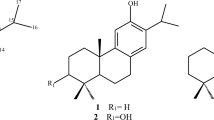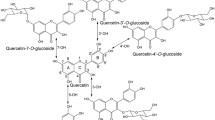Abstract
Radical scavenging potential is the key to anti-oxidation of hydroxyflavones which generally found in fruits and vegetables. The objective of this work was to investigate the influence of hydroxyl group on the O-H bond dissociation enthalpies (BDE) from a series of mono- and dihydroxyflavones. Calculation at the B3LYP/6-31G(d,p) level reveals the important roles of an additional one hydroxyl group to boost the BDE of hydroxyflavones that were a stabilization of the generated radicals through attractive H-bond interactions, an ortho- and para-dihydroxyl effect, and a presence of the 3-OH in dihydroxyflavones. On the other hand, the meta-dihydroxyl effect and range-hydroxyl effect especially associated with the either 5-OH or 8-OH promoted greater BDE. Results did not only confirm that dihydroxyflavones had lower BDE than monohydroxyflavones but also suggest the selective potent hydroxyflavone molecules that are the 6′-hydroxyflavone (for monohydroxyflavone) and the 5′,6′-, 7,8- and 3′,4′-dihydroxyflavone which the corresponding radical preferable generated at C6′-O•, C8-O• and C4′-O•, respectively. Electron distribution was limited only over the two connected rings of hydroxyflavones while the expansion distribution into C-ring could be enhanced if the radical was formed especially for the 2′,3′- and 5′,6′dihydroxyflavone radicals. The delocalized bonds were strengthened after radical was generated. However the 5-O• in 5,6-dihydroxyflavone and the 3-O• in 3,6′-dihydroxyflavone increased the bond order at C4-O11 which might interrupt the conjugated delocalized bonds at the keto group.

This work suggests that a preferable region of the catechol group in dihydroxyflavones was selective. The 5′,6′-, 7,8-, and 3′,4′-dihydroxyflavone, which had the corresponding radical at C6′-O•, C8-O• and C4′-O•, shows higher potential of H-atom donation than others.






Similar content being viewed by others
References
Manach C, Scalbert A, Morand C, Rémésy C, Jiménez L (2004) Polyphenols: food sources and bioavailability. Am J Clin Nutr 79:727–747
Hertog MGL, Feskens EJM, Hollman PCH, Katan MB, Kromhout D (1993) Dietary antioxidant flavonoids and risk of coronary heart disease: the zutphen elderly study. Lancet 342:1007–1011
Soobrattee MA, Neergheen VS, Luximon-Ramma A, Aruoma OI, Bahorun T (2005) Phenolics as potential antioxidant therapeutic agents: mechanism and actions. Mutat Res Fundam Mol Mech Mutagen 579:200–213
Cheng Z, Ren J, Li Y, Chang W, Chen Z (2002) Study on the multiple mechanisms underlying the reaction between hydroxyl radical and phenolic compounds by qualitative structure and activity relationship. Bioorg Med Chem 10:4067–4073
Iannitti T, Palmieri B (2009) Antioxidant therapy effectiveness: an up to date. Euro Rev Med Pharmacol Sci 13:245–278
Mira L, Fernandez MT, Santos M, Rocha R, Florêncio MH, Jennings KR (2002) Interactions of flavonoids with iron and copper ions: a mechanism for their antioxidant activity. Free Radic Res 36:1199–1208
Sogawa S, Nihro Y, Ueda H, Izumi A, Miki T, Matsumoto H, Satoh T (1993) 3,4-Dihydroxychalcones as potent 5-lipoxygenase and cyclooxygenase inhibitors. J Med Chem 36:3904–3909
Huang D, Boxin OU, Prior RL (2005) The chemistry behind antioxidant capacity assays. J Agric Food Chem 53:1841–1856
Zhang HY, Sun YM, Wang XL (2003) Substituent effects on O-H bond dissociation enthalpies and ionization potentials of catechols: a DFT study and its implications in the rational design of phenolic antioxidants and elucidation of structure - activity relationships for flavonoid antioxidants. Chem Eur J 9:502–508
Rastija V, Medić-Šarić M (2009) QSAR study of antioxidant activity of wine polyphenols. Eur J Med Chem 44:400–408
Bors W, Heller W, Michel C, Saran M (1990) Flavonoids as antioxidants: determination of radical-scavenging efficiencies. Methods Enzymol 186:343–355
Park Y, Lee S, Woo Y, Lim Y (2009) Relationships between structure and anti-oxidative effects of hydroxyflavones. Bull Korean Chem Soc 30:1397–1400
Park Y, Lee YU, Kim H, Lee Y, Yoon YA, Moon B, Chong Y, Ahn JH, Shim YH, Lim Y (2006) NMR data of flavone derivatives and their anti-oxidative activities. Bull Korean Chem Soc 27:1537–1541
Hyun J, Woo Y, Hwang DS, Jo G, Eom S, Lee Y, Park JC, Lim Y (2010) Relationships between structures of hydroxyflavones and their antioxidative effects. Bioorg Med Chem Lett 20:5510–5513
Modelli A, Pshenichnyuk SA (2013) Gas-phase dissociative electron attachment to flavonoids and possible similarities to their metabolic pathways. Phys Chem Chem Phys 15:1588–1600
MacHado NFL, Valero R, Domingos HS, Tomkinson J, Batista De Carvalho LAE, Otero JC et al (2012) Conformational behaviour of antioxidant chromones. A vibrational spectroscopy study. Vib Spectrosc 63:325–337
Trouillas P, Marsal P, Siri D, Lazzaroni R, Duroux JL (2006) A DFT study of the reactivity of OH groups in quercetin and taxifolin antioxidants: the specificity of the 3-OH site. Food Chem 97:679–88
Leopoldini M, Prieto Pitarch I, Russo N, Toscano M (2004) Structure, conformation, and electronic properties of apigenin, luteolin, and taxifolin antioxidants. A first principle theoretical study. J Phys Chem A 108:92–96
Sadasivam K, Kumaresan R (2011) Antioxidant behavior of mearnsetin and myricetin flavonoid compounds - a DFT study. Spectrochim Acta A Mol Biomol Spectrosc 79:282–293
Frisch MJ, Trucks GW, Schlegel HB, Scuseria GE, Robb MA, Cheeseman JR et al (2009) Gaussian 09, Revision B.01. Gaussian Inc, Wallingford CT
Frisch A, Dennington R, Keith T (2003) GaussView Version 3.0. Gaussian Inc, Pittsburgh, PA
Cornard JP, Vrielynck L, Merlin JC, Wallet JC (1995) Structural and vibrational study of 3-hydroxyflavone and 3-methoxyflavone. Spectrochim Acta A Mol Biomol Spectrosc 51:913–23
Shoja M (1990) 5-Hydroxyflavone. Acta Crystallogr C 46:517–9
Pietrogrande MC, Reschiglian P, Dondi F, Kahie YD, Bertolasi V (1992) Correlations between high-performance liquid chromatographic retention, X-ray structural and 13C NMR spectroscopic data of flavonoid compounds. J Chromatogr A 592:65–73
Machado NFL, Batista De Carvalho LAE, Otero JC, Marques MPM (2013) A conformational study of hydroxyflavones by vibrational spectroscopy coupled to DFT calculations. Spectrochim Acta A Mol Biomol Spectrosc 109:116–124
De Toledo TA, Da Silva LE, Botelho TC, Ramos RJ, De Souza PT, Teixeira AMR et al (2012) Characterization of flavonoid 3-Methoxyquercetin performed by FT-IR and FT-Raman spectroscopies and DFT calculations. J Mol Struct 1029:22–27
Mulder P, Korth HG, Pratt DA, DiLabio GA, Valgimigli L, Pedulli GF, Ingold KU (2005) Critical re-evaluation of the O − H bond dissociation enthalpy in phenol. J Phys Chem A 109:2647–2655
Blanksby SJ, Ellison GB (2003) Bond dissociation energies of organic molecules. Acc Chem Res 36:255–263
Vakarelska-Popovska MH, Velkov ZA (2014) Structure of flavones and flavonols. Part II: role of position on the O-H bond dissociation enthalpy. Comput Chem 2:1–5
Thavasi V, Bettens RP, Leong LP (2009) Temperature and solvent effects on radical scavenging ability of phenol. J Phys Chem A 113:3068–3077
Amić D, Lučić B (2010) Reliability of bond dissociation enthalpy calculated by the PM6 method and experimental TEAC values in antiradical QSAR of flavonoids. Bioorg Med Chem 18:28–35
Vagánek A, Rimarčík J, Lukeš V, Klein E (2012) On the energetics of homolytic and heterolytic OH bond cleavage in flavonoids. Comput Theor Chem 991:192–200
Acknowledgments
The authors gratefully thank the Thailand Research Fund (RTA5380010) for financial support. The research facilities at the Laboratory for Computational and Applied Chemistry (LCAC) were made available through the generosity of the National Center of Excellence in Petroleum, Petrochemical Technology and Advanced Materials, the Center of Nanotechnology at Kasetsart University, and the National Research University Program. Support and language correction by native speaker provided from the Kasetsart University Research and Development Institute (KURDI) is also acknowledged.
Compliance with Ethical Standards
The manuscript has not been submitted elsewhere.
This study was funded by the Thailand Research Fund (RTA5380010).
Partial support from Laboratory for Computational and Applied Chemistry (LCAC), the Kasetsart University Research and Development Institute (KURDI), the National Center of Excellence in Petroleum, Petrochemical Technology and Advanced Materials, the National Research University Program was facilitated to this work.
Author information
Authors and Affiliations
Corresponding author
Rights and permissions
About this article
Cite this article
Treesuwan, W., Suramitr, S. & Hannongbua, S. Elucidation of hydroxyl groups-antioxidant relationship in mono- and dihydroxyflavones based on O-H bond dissociation enthalpies. J Mol Model 21, 137 (2015). https://doi.org/10.1007/s00894-015-2669-2
Received:
Accepted:
Published:
DOI: https://doi.org/10.1007/s00894-015-2669-2




